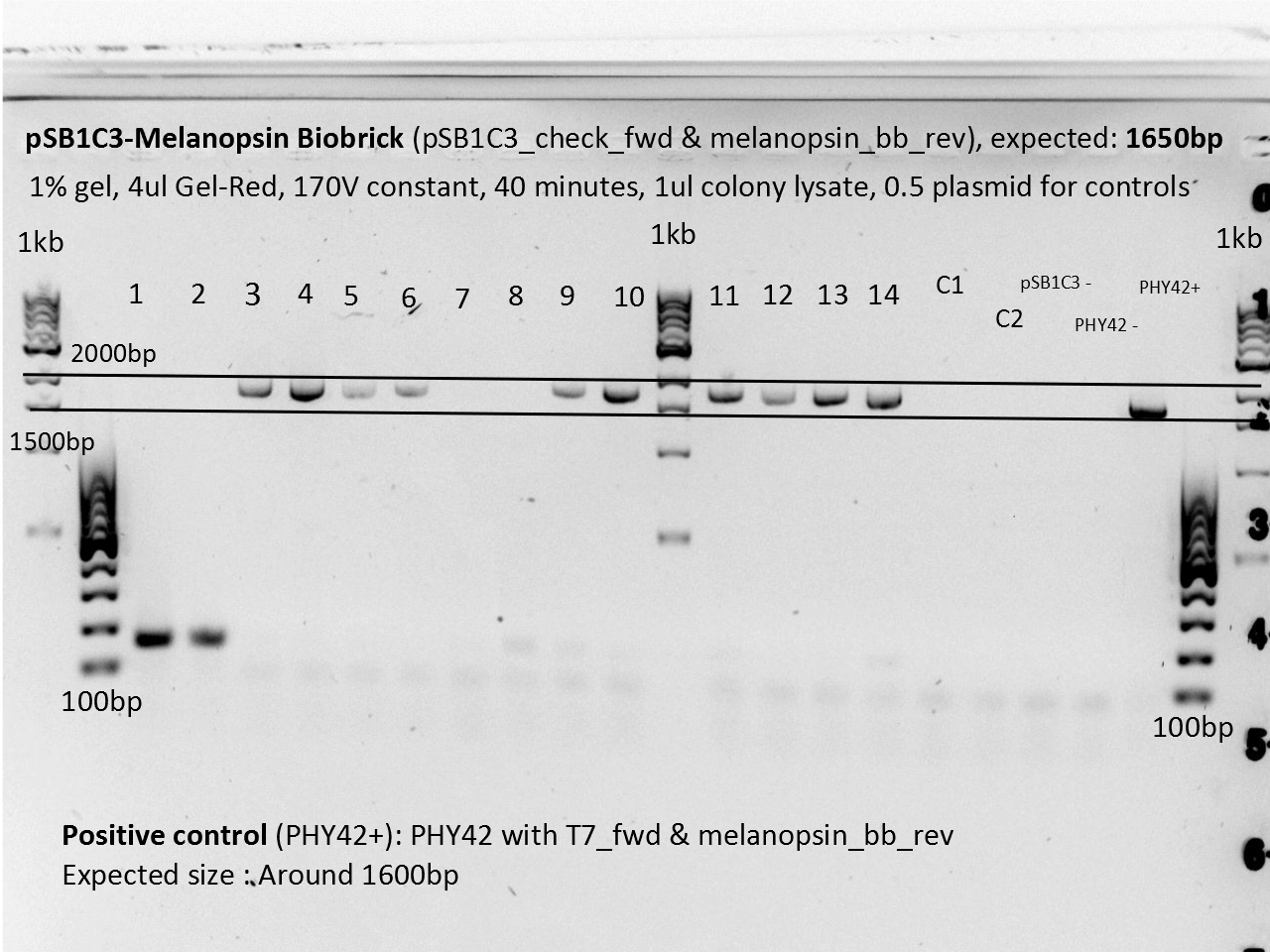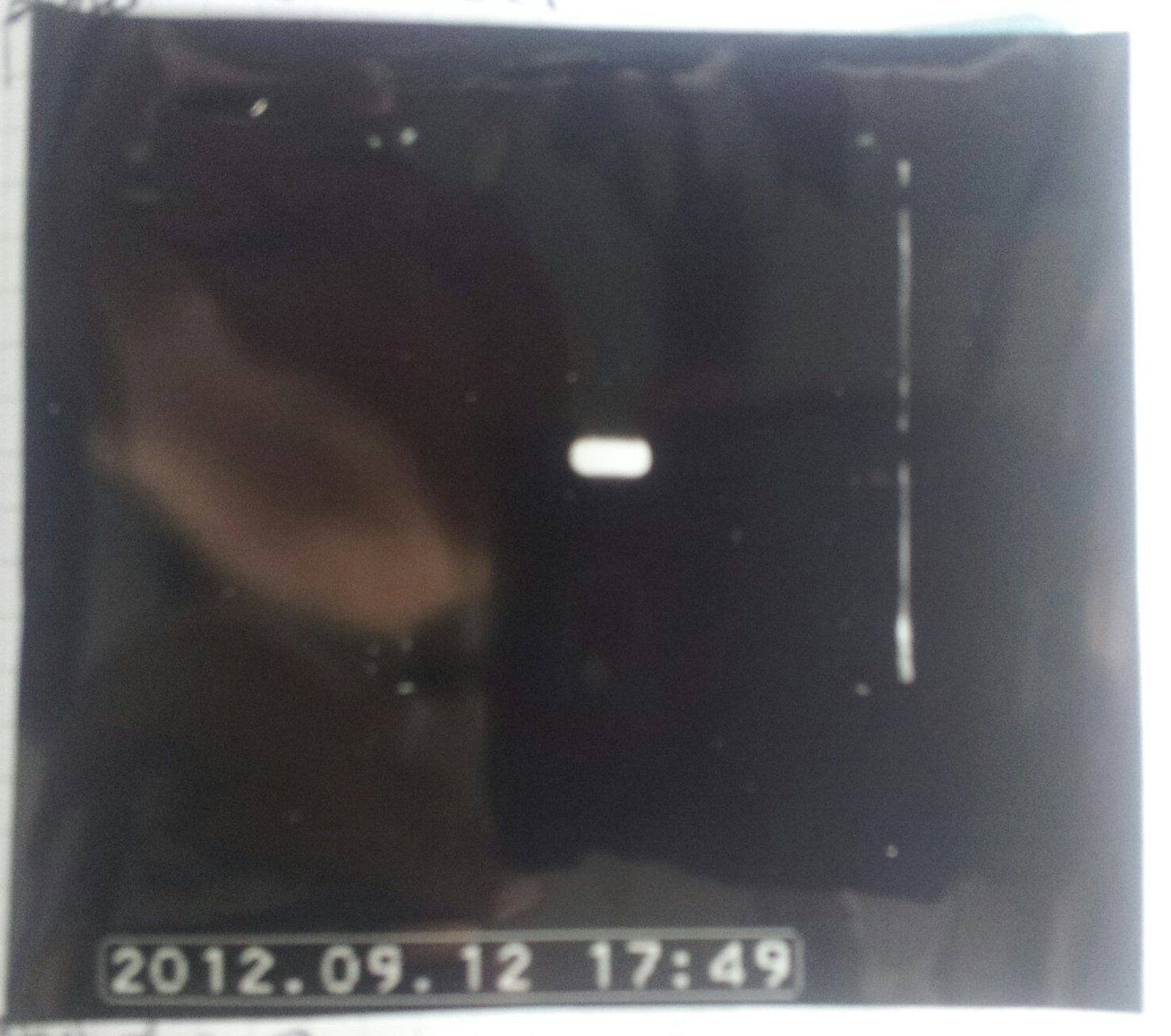Contents |
Melanopsin Biobrick colony PCR
Protocol: PCR
PCR is a reaction that makes it possible (and relatively easy) to amplify
a certain region of DNA. The first step is the selection of that region
(and the design of the relevant primers). Primer design can be done by hand, or by
using our Primer Design Helper. Once
done, order the primers (in our case, we ordered from them IDT).
When you've received the primers, prepare them and make sure you've got your PCR kit (we used the "Phusion® High-Fidelity DNA Polymerase"). Start preparing your master mix, the composition for one tube is:
1X Mastermix 20μl reaction, add in this order
| Reagent | Volume [μl] |
|---|---|
| Water | Complete to total volume of 20μl |
| HF-Buffer (5x) | 4 |
| DMSO (optional) | 0.6 |
| dNTPs | 0.4 |
| Forward primer (50μM) | 0.2 |
| Reverse primer (50μM) | 0.2 |
| Template (10ng/μl) | 0.5 |
| Phusion HF polymerase | 0.2 |
Prepare one or two extra tubes-worth of reagent (you'll use some liquid on the walls of your tips).
Once you've finished, you should run the resulting products on a gel to check if everything went as planned.
Tips
- Thaw the HF-Buffer, DMSO and dNTPs before making the mastermix.
- Avoid taking the Phusion-HF polymerase out of the freezer (only take it out briefly when you need to add it).
- If the reactions have different primers and/or template, add the polymerase right after the dNTPs, split the mastermix and add the rest.
- Don't forget positive and negative controls
- Primers should have similar Tms (less than 5°C).
- Primer Tm calculation is a less exact science than it should be (just test several tools and compare their results). If you're not sure what the correct Tm is, consider using a gradient PCR.
- Avoid primers with strong secondary structures.
- PCR can introduce mutations. Don't forget to sequence your final product (this could be your final plasmid): you really don't want to lose a few weeks because of a "corrupt" plasmid.
Colony PCR was performed on the lysed colonies from the day before, 14 from the pSB1C3-Melanopsin plate and 2 from the control plate.
Positive control: PHY42+: PHY42 with T7_fwd & melanopsin_bb_rev Expected size : Around 1600bp
Negative controls: pBS1C3 - = pSB1C3 with pSB1C3_check_fwd & melanopsin_bb_rev PHY42- = PHY42 (melanopsin) with pSB1C3_check_fwd & melanopsin_bb_rev
PCR with HF-Buffer (5x) and DMSO at 63°C with 1ul colony lysate as template.
Results:
This looks like a working BioBrick.
LovTAP Readout Maxiprep
Protocol: MaxiPrep
The evening before, take a big Erlenmeyer (at least 1L) and put 200ml LB in it. Add the appropriate antibiotics at the correct concentration (ampicilin: 200ul of 100mg/ml solution). Put in bacteria from a single colony of a freshly streaked plate or from a glycerol stock (warning: taking bacteria from glycerol stock seems to cause them to start growing later - due to thawing? - add one-two hours to the incubation time). Put them in the incubator for 14-15 hours (the contents of the bottle should be yellow-ish between translucid and opaque).
We then use the MaxiPrep kit (Plasmid DNA Purification kit) and protocol from Macherey-Nagel.
The complete handbook can be found here. We usually use the protocol that starts at page 24 for "Maxi".
The culture was made, then the DNA was extracted. The pellet was lost in the process. It yielded an inexistent DNA concentration. Started yet another maxiprep of the Read-out plasmid.
NFAT gel extraction
Protocol: Gel Extraction
A gel extraction is used to select a fragment of DNA of a specific length
out of a solution composed of different fragments (ideally the difference
in length between the wanted fragment and the closest-sized fragment should
be more than 200bp). These fragments are often obtained after a
digestion.
The yeild for this procedure is typically very poor so a large amount of starting material, digested DNA in this case is required. We typically used 4 micrograms. The digestion products are loaded on a gel. Lanes on both sides of the one to be extracted should be empty to make cutting easier and avoid contamination with other fragments.
The gel should be run long enough for the bands to be spread out. This is particularly important if the fragment of interest is around the same length as other expected digestion products. UV light is necesary to observe the bands on the gel but exposure time should be minimized to avoid DNA damage. The fragment of interest is then excise and put in an Eppendorf (consider using a 2ml one).
To extract the DNA from the agarose we used Macherey-Nagel's "Nucleospin® Gel and PCR clean-up" kit. Its manual can be found here: Gel and PCR clean-up Manual
Tips
- Cut away as much Agar as possible without slicing into the DNA. Excess agar will require more solvent to dissolve and will result in a poorer yeild upon elution.
- Minimize the DNA's exposure to the UV-light. UV will damage DNA and have negative effects on any subsequent reactions (for example, ligations can be 10'000x less effective when DNA has been exposed to too much UV light [1]
PCR products from three NFAT PCR reactions were digested with EcoRI and SpeI for ligation, and then a cleanup was done on a gel due to a competing PCR reaction being present (we see nonspecific binding of the primer). This allowed for a cleaner product for our ligation fragment.
Nanodrop of the gel extraction result
Protocol: DNA Concentration Measurement
- Take a 6 µl aliquote of the DNA and put back the main DNA tube in the fridge.
- Go to the room by the E.Coli lab (LBTM, not on Friday morning!) with:
- The 6 µl aliquote
- A 10 µl pipet
- Optionally, the buffer you used for DNA elution (there might be some next to the machine).
- The machine is the NanoDrop Spectrophotometer.
- On the computer, click on "Nucleic Acid".
- Put a 2 µl drop of (nuclease-free) water on the machine's tip as you are asked to and measure.
- Clean tips (both sides) with a quarter of tissue.
- Add 2 µl of the buffer you use and click on "Blank".
- Clean tips (both sides).
- Add 2 µl of your DNA sample and click "Measure".
- Clean tips (both sides) with a tissue.
- Take 2 measurements per sample (for averaging).
- Print the report when you are done
- Click on exit.
The important numbers are:
- 260/280 ratio, must be > 1.8
- 260/230 ratio, must be > 2 (too big, > 2.5? , might mean too much salts)
- Of course the DNA concentration.
The DNA was at an acceptable concentration (32.9 ng/µl).
 "
"

